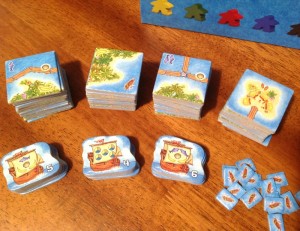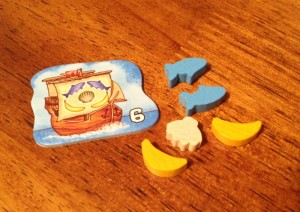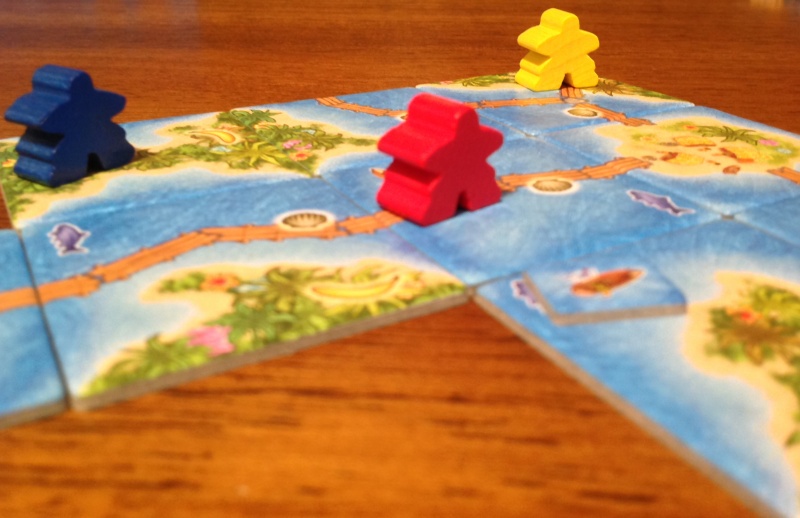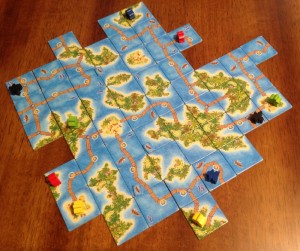 I’ve been an active member of the board gaming community for only a little over a year now, but in that relatively short amount of time, my love/obsession for the hobby (not to mention my game collection) has grown faster than I ever thought possible. Like many others, my introduction into the “modern” or “Euro” style of board gaming started with three of the most well-regarded “gateway” games: Settlers of Catan, Ticket to Ride, and Carcassonne. Of those three games, Carcassonne is the one that I was immediately drawn to and has had the most impact on me. After learning the game myself, I couldn’t wait to teach it to family, friends, and strangers on the street (ok, maybe not that last one). In addition, the completionist in me just HAD to collect every expansion, promo, and stand alone game related to Carcassonne.
I’ve been an active member of the board gaming community for only a little over a year now, but in that relatively short amount of time, my love/obsession for the hobby (not to mention my game collection) has grown faster than I ever thought possible. Like many others, my introduction into the “modern” or “Euro” style of board gaming started with three of the most well-regarded “gateway” games: Settlers of Catan, Ticket to Ride, and Carcassonne. Of those three games, Carcassonne is the one that I was immediately drawn to and has had the most impact on me. After learning the game myself, I couldn’t wait to teach it to family, friends, and strangers on the street (ok, maybe not that last one). In addition, the completionist in me just HAD to collect every expansion, promo, and stand alone game related to Carcassonne.
When a new stand alone game called Carcassonne: South Seas (the first in a new series called “Carcassonne Around the World”) was announced recently, I was intrigued. Designer Klaus-Jürgen Wrede has taken the familiar game play mechanics of drawing a landscape tile, placing it on the ever-expanding map, and claiming a part of the map by deploying a “meeple” figure, and added some fresh twists to it, such as collecting wares and delivering them on ships to earn points. In my first review for Board Game Quest, I’ll attempt to explain why I believe a trip to Carcassonne: South Seas should be on any gamer’s itinerary.
Carcassonne: South Seas is “a clever tile-laying game set in an island paradise” for 2 to 5 players and plays between 35 to 60 minutes. Carcassonne: South Seas plays best with 4 or 5 players.
Game Overview:

In Carcassonne: South Seas, players control a set of “Islanders” that will populate various features on the Sea tiles. These features include Bridges (comparable to the Roads of the original Carcassonne game), Islands (comparable to Cities), and Sea Regions (comparable to Farms). There are also single-tile Markets (similar to Cloisters). Except for the Markets, which will be explained later, each feature on a tile may contain one or more Wares symbols (Shells on Bridges, Bananas on Islands, and Fish OR Fishing Boats on Sea regions) to denote the goods that can be collected by a player if they complete a feature. When a player collects Wares that match the assortment showing on one of the four face-up Ship tokens, they “deliver” those Wares, thereby earning points. The game ends when either all tiles have been played, or all Ship tokens (24 in all) have been claimed. After some additional end game scoring, the player with the most points is the winner.
Game Components:
As in the original Carcassonne game, as well as several of the other stand alone Carcassonne titles, the main components are a set of landscape tiles (called Sea tiles here), and a collection of wooden meeples. The tiles are of the same size and sturdy quality as you’d find in any previous Carcassonne game, designed with vivid, tropically-colored landscape features. The meeples are also the same brightly-painted wooden figures we’re familiar with, but in keeping with the South Seas island theme, it looks like they’ve been given a grass skirt makeover.
In addition to the meeples, there are 3 types of wooden bits for the Wares: Shells, Bananas, and Fish, each available in two sizes. There are also some small Fishing Boat tokens (cleverly used), and a set of larger Ship tokens, depicting various assortments of Wares. Gamers familiar with Carcassonne will notice that there is no scoring track to be found in Carcassonne: South Seas; the scoring is done with the point values printed on the Ship tokens accumulated during the game. Read on to learn how these new components are used.
How to Play:

Each player takes the 4 Islander meeples in their chosen color. The Ship tokens are shuffled and 4 of them are placed face up to form the current Wares delivery choices. As in the original Carcassonne, a starting tile is placed in the center of the table, and players take turns drawing a tile and placing it on the table, connecting like features (Island segments to Islands, Bridge segments to Bridges, and Sea regions to Seas). A player may then place a meeple on one of the features of the just-played tile, in order to claim that feature (as long as that feature hasn’t already been claimed by another player).
Instead of placing a meeple, a player may retrieve a meeple of his color from anywhere on the board (this becomes more important later in the game, as players only have 4 meeples to work with). There is also the option to neither place nor retrieve a meeple, if the player chooses.
Play continues in clockwise order, with each player laying down another tile, and either placing or retrieving a meeple. If a Bridge is completed, the player whose meeple occupies the Bridge receives 1 Shell piece for each Shell symbol present on the completed Bridge. Likewise, a completed Island gives Bananas, and a completed Sea region gives Fish.
Sea regions work a little differently however, since they, like Farms in the original Carcassonne game, are usually open-ended and continue to grow throughout the game, without really being “completed”. The awarding of Fish pieces in most cases will therefore be handled by this special rule: Whenever a Sea tile is placed featuring a Fishing Boat symbol (instead of a Fish symbol), a player whose meeple occupies the connecting Sea region receives Fish pieces for each Fish symbol that appears throughout the region, even though the region is not technically “complete”. After Fish are awarded in this way, due to placement of a Fishing Boat on a tile, the player takes one of the small Fishing Boat tokens and covers one group of Fish symbols (1 or 2 Fish) in the region. By doing this, any future placement of tiles containing Fishing Boats in that same region will have a reduced number of Fish awarded. Of course, it is also possible for a Sea region to be completely enclosed by Bridges and/or Islands, and Fish can be awarded in the more usual manner in that case. When any feature is completed and Wares awarded, any meeples present on the completed feature are returned to their owner’s supply, to be used again later.
As a final optional step in a player’s turn, he may deliver Wares to 1 (and only 1) Ship, if he owns Wares that match the assortment on one of the four face-up Ship tokens. He returns the appropriate Wares to the supply, and places the matching Ship face down in front of him. This ship will earn the player between 3 and 6 points at the end of the game. Another face-down tile is drawn to replenish the available Ship choices to four.
An alternate way to earn Ships, without needing to deliver Wares, is by completing a Market feature on the map. As with the Cloisters in the original Carcassonne, a Market is completed by surrounding all 8 sides with tiles. When this happens, the player with a meeple on the completed Market can freely choose any one of the available Ship tokens (most likely the highest-scoring one) and place it face-down in front of him.
The game ends after the turn in which the last Sea tile is placed or the last Ship token has been acquired. Each player can then gain some end-of-game Wares on any incomplete features as if they were complete (with the exception of Markets). Points are then totaled for the amount on each acquired Ship, plus any remaining Wares at a 3 Wares = 1 point ratio. The highest scoring player wins the game.

Game Experience:
Since receiving the game, I’ve played with 3, 4, and 5 players, and I think having more players opens up more opportunities overall. There will be more newly-placed tiles by the time your turn comes around again, meaning more options for placing your own drawn tile to the best advantage. Although I haven’t tried it with only 2 players yet, I feel that it could limit the game somewhat.
I really like the way the Sea regions can be “scored” for Fish, and how the rule of covering one of the awarded Fish symbols with a Fishing Boat token eliminates any future scoring of those Fish. This adds a moderate “screw your neighbor” element to the game, which occurred in every game played so far. One player would place their meeple on a Sea region to claim it, but was never able to draw a tile with a Fishing Boat symbol to collect the Fish in the region. Ultimately, other players would collect the surrounding Fish by being lucky enough to place a Fishing Boat tile, which left the original meeple in a Sea region, which can easily wind throughout large portions of the playing field, with no Fish left in it.
I also like the variety of delivery options on the Ship tiles. In addition to Ships that show specific Wares that will claim it, there are some “wild card” Ships, which will require a certain amount of Wares, but can be fulfilled using any type of Ware. In addition, having this type of Ship scoring instead of the usual victory track scoring opens up a slightly different strategic element to the game. Instead of long-term planning to build that huge City or longest Road, players will find themselves trying to complete features as quickly as possible, in order to collect the Wares needed to grab up the highest-scoring Ship on display before someone else does.

Another new strategic twist that involves the Ship scoring revolves around claiming a Market feature. If you are the one trying to complete a Market, you’ll be hoping that a 6-scoring Ship will be available when it comes time to choose your Market completion reward. On the flip side, if there are only low scoring Ships on display, your opponents will be all too happy to “help” you finish your Market, so that you’ll be forced to take a 3-point Ship.
The group I played with (ranging from adults to pre-teens) were all familiar with the original Carcassonne game, so learning this game was very easy for everyone, and we all had a “let’s play one more game” feeling after finishing a game, which is always a good sign that this will make it to the table often.
There was one potential negative to the game, at least among the group I was playing with. During the end game scoring, when collecting Wares for the remaining incomplete features, we were all expecting to be able to deliver those Wares to score some additional Ships. However, the rules don’t mention anything about this, and only the remaining Wares themselves can add a small amount of points (1 per 3 Wares) to the final score. This can always be incorporated into a house rule, of course, so it’s definitely not a negative of the game as a whole.
One final note: my copy of the game came with a mini-expansion called “Freitag”, which translates in English to “Friday”, a reference to the character in the Daniel DeFoe novel Robinson Crusoe. This expansion adds 6 tiles which introduce variants to the rules (earning extra Wares for completed features, the ability to trade Wares between players, etc.) and is a fun little addition once the rules of the base game are grasped.
Final Thoughts:
This new title in the Carcassonne family maintains the easy-to-medium play level of most of the others, and like those others, there is still something satisfying about seeing your game “map” being built and growing on the table one tile at a time. Carcassonne games in general are not “brain-burners”, but they always fit well into a game night, either as a lighter game to start the session, or a “palate cleanser” after a heavier game. If you are new to the Carcassonne world, Carcassonne: South Seas is just as easy to jump into as the original game. For veterans, this game keeps with the basic Carcassonne rules with a few fresh objectives. This bodes well for future titles in the “Carcassonne Around the World” series and I’m interested to see what Klaus-Jürgen Wrede comes up with next. I think Carcassonne: South Seas will provide enough interesting new elements to make it a worthwhile addition to your game collection.
Final score: 4 Stars – A light-to-medium tile laying game that keeps many of the familiar Carcassonne elements, while shaking things up enough to keep it interesting.
If you are interested in getting a copy for yourself, it’s about $28
 Hits:
Hits:
• Easy to learn.
• Not a long game, so multiple plays are usually welcome.
• Some new strategies which can be nice or nasty, depending on the play style of your group.
Misses
• Players should be able to score additional Ships at the end of the game with the Wares they accumulate from incomplete regions during the end game scoring.




















